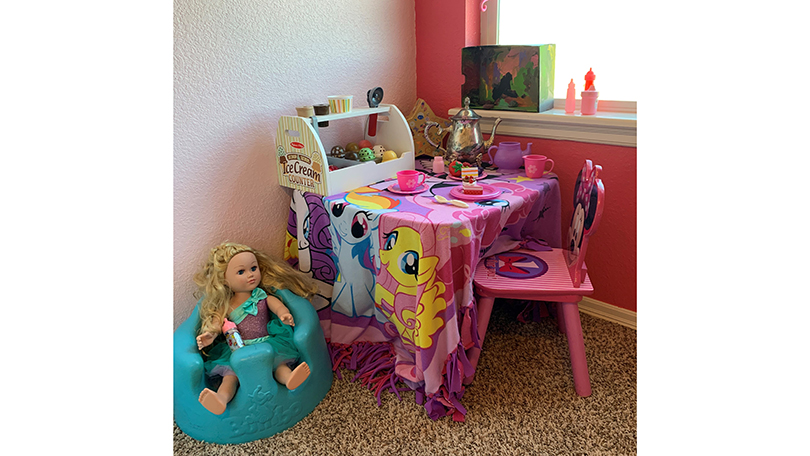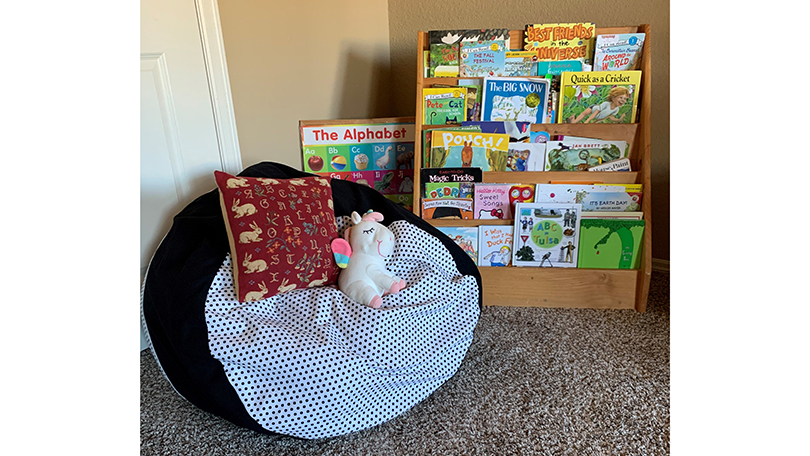Playing to Learn – Home Edition
by Stephanie Daniels View Bio
Stephanie Daniels is a Child Care Consultant with the Child Care Resource Center in Tulsa, Oklahoma. She has an Associate of Science in Middle Childhood from Tulsa Community College and a Bachelor of Arts in Human Development and Family Science from Oklahoma State University. She has worked in the early childhood field for over 20 years as a teacher, nanny, literacy specialist and childcare consultant. For the 2019-2020 school year, she was chosen as a Senior Play Ambassador with The Genius of Play.
At the state level, she serves on the Oklahoma Out-of-School Time Taskforce and the Quality Rating Improvement System committee. She is passionate about school-age care, play-based learning, creative art, and access to quality care for children of all ages.
-
Here are 5 easy steps to setting up learning centers in your home:
- Collect the toys and materials you have available.
- Group like materials into categories.
- Organize them on a shelf or in baskets/tubs on the floor.
- Place a nearby table and chairs or area on the floor to play with the materials.
- Introduce the learning centers to the children and let them choose what they would like to play.
Hybrid learning (combination of both virtual and in-person) for your preschool or elementary student is challenging, then add a full-time job and other household responsibilities to that, and it may become very taxing. It can be a very heavy weight to have your child’s academic success fall on you, especially knowing teachers attend school to learn how to teach and you have been thrust into a “learning guide” position with no notice! Parents continue to feel the pressures of ensuring their children stay on track academically and continue to learn as well as take care of their mental health and minimize their stress.
Research shows that children (especially young children) learn best through play. That’s why most childcare, preschool, pre-k, and kindergarten classrooms are arranged in “learning centers.” Learning centers provide the same information in a variety of ways thus meeting the needs of a variety of learning styles. They enable children to engage in play and learn through the method that is best for them. They also provide natural situations in which children have opportunities to develop and practice social, emotional, and problem-solving skills. Some common learning centers are blocks, art, dramatic play, math, science, reading, and manipulatives. Teachers often set up these centers with interesting, age-appropriate materials for the children to choose from.
A child is more likely to stay engaged in an activity if they choose it, which aids in developing longer attention spans and learning to focus.
Play not only aids in learning, but is also shown to reduce stress and help build relationships between the child and caregiver when they engage in play together. Children often act out situations through dramatic play to gain a deeper understanding and learn how to problem solve. During the pandemic, you might hear children talking about using hand sanitizer, taking temperature, quarantining, or giving vaccines. This is how they make sense of everything that is happening around them.
Below are some examples of materials that may be included in specific learning centers. Please note, this list is not exhaustive nor required, only suggestions of possible learning centers and materials. Use your knowledge of your child’s interests and abilities to make it your own:
Art
- Paper and other drawing surfaces (aluminum foil, sandpaper, coffee filters)
- Drawing implements (crayons, markers, colored pencils)
- Watercolors and other washable paints (tempera, finger paints)
- Adhesives (white glue, clear glue, glue sticks)
- Tools (scissors, hole punch, stapler, ruler)
- Collage materials (cotton balls, corks, ribbon, tissue paper, rocks, leaves, sand, pasta, beans)
- Clay and play dough
Blocks
- Blocks (you can buy inexpensive cardboard or foam blocks)
- Block accessories (animals, people, vehicles)
Dramatic Play
- Dress-up clothes
- Dolls and accessories (clothes, bottles, diapers)
- Stuffed animals and puppets
- Pretend materials (doctor’s kit, dishes)

Math
- Pattern blocks
- Measuring materials (scales, rulers, measuring cups)
- Sorting materials (by color, size, shape)
- Number toys (abacus, dice)
- Shape toys
- Calculators
- Card games
- Board games
Science
Reading
- Books of varying topics (nonfiction and fiction)
- Cozy materials (pillows, beanbags, blankets, stuffed animals, puppets)

Manipulatives
- Construction sets (LEGO, bristle blocks, K’Nex, Lincoln Logs, waffle blocks)
- Puzzles
- Lacing cards
- Beading sets
Although it can feel overwhelming to juggle your children’s virtual learning and other responsibilities, providing opportunities for them to choose what and how they want to learn for at least a portion of the day can help reduce stress and expand on what they are learning from school. Play is powerful! Visit the Child Care Resource Center’s Pinterest for more ideas on learning through play.